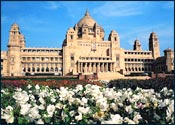|
|
|
|
|
|
|
|
|
| Jodhpur Introduction |
|
 Jodhpur , the bustling desert city, is considered as the second largest city in Rajasthan after Jaipur and has landscape dominated by the massive Meherangarh Fort topping a sheer rocky ridge. Jodhpur was once the capital of the former princely state. In Jodhpur , the genius of ancient craftsmen comes to life in the exquisite palaces, forts, temples and havelis, or homes, which stand testimony to the imperial grandeur of the erstwhile rulers of the state. The most alluring part of Jodhpur is the traditional lifestyle and festivity, and the smiling people of this former princely state. It boasts of some very fine reminders of its glorious past - palaces, temples and other elegant monuments of architectural and historical value. Jodhpur , the bustling desert city, is considered as the second largest city in Rajasthan after Jaipur and has landscape dominated by the massive Meherangarh Fort topping a sheer rocky ridge. Jodhpur was once the capital of the former princely state. In Jodhpur , the genius of ancient craftsmen comes to life in the exquisite palaces, forts, temples and havelis, or homes, which stand testimony to the imperial grandeur of the erstwhile rulers of the state. The most alluring part of Jodhpur is the traditional lifestyle and festivity, and the smiling people of this former princely state. It boasts of some very fine reminders of its glorious past - palaces, temples and other elegant monuments of architectural and historical value.
We at StayResIndia.com , a leading inbound tour operator in India , promote tourism in Jodhpur and can book hotels and resorts in Jodhpur as per your budget. We maintain very good professional relationship with all the major hotel chains and independent properties in India including Jodhpur . It helps us in offering you competitive hotel and resorts tariffs in Jodhpur.
|
|
|
|
|
Top ˆ |
| Tourist Attractions in Jodhpur |
|
|
| § Mehrangarh Fort |
|
Mehrangarh Fort is about 5 kms from Jodhpur Town . Situated on a steep hill, Mehrangarh Fort is one of the largest forts in India . The fort has been a witness to the splendor of a bygone era. The beauty and the grandeur of numerous palaces in the fort narrates a saga of hard sandstones yielding to the chisels of skilled Jodhpuri sculptures. To enter the Mehrangarh fort, seven gates have to be crossed. Some of these gates still bear marks of many a siege that this fort has withstood. This formidable fort is among the best in India with exquisitely latticed windows in residential apartments within.
|
|
|
| § Jaswant Thada |
|
Close to the Mehrangarh fort lies this 19th century royal cenotaph, built in white marble, in commemoration of Maharaja Jaswant Singh. Rare portraits of Jodhpur 's rulers are also displayed here. It was small, but still had features that were delicate and unique. Some stones are so thin and highly polished that the sunlight illuminates them, causing a warm glow inside. Also, the building has wonderful views over the city and of the fort.
|
|
|
| § Umaid Bhawan Palace |
|
The only palace to be built in the 20th century, as a famine relief project which gave employment to people for 16 years. Its sculpted lawns with sandstone pavements and bougainvillea bushes are a soothing sight in the midst of this desert city. Built by Maharaja Umaid Singh (1929 -1942) and named after him, this exquisite palace is also known as Chittar Palace because of the local chittar sandstone used. The palace now runs as a hotel, though a part of it has been retained as a museum and part as royal residence.
|
|
|
| § Government Museum |
|
Located in the Umaid gardens on High Court Road , it has a large and fairly interesting collection. The museum was established in 1909. T his museum houses a rich collection of exhibits - armory, textiles, local arts and crafts, miniature paintings. It also displays portraits of rulers, manuscripts and images of Jain Tirthankars. Umaid Public Garden houses a zoo also.
|
|
|
|
|
Top ˆ |
|
|
|
|











